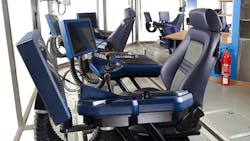In the 1956 movie “Giant,” James Dean plays a wildcatter who strikes it rich when he finds oil on his Texas land. The wildcatting days depicted in this and other movies and TV shows like “The Beverly Hillbillies” bear no resemblance to the oil business of today. “Today, oil drilling is a manufacturing process, with 97 percent success rate, at least in shale,” says Don Norman, director of economic studies at the MAPI Foundation.
In his general session presentation at the Siemens Oil & Gas Innovations Conference in Houston last week, Norman talked primarily about oil prices—historical trends in relation to low prices today, and how it all relates to production and capacity levels. But his point about oil exploration being a manufacturing process was one echoed throughout the conference.
The question on many people’s minds these days is how low oil prices are affecting growth in the market and capital (specifically automation) spends. As Norman pointed out, certainly, the lower price of oil is making it less profitable to drill, but that equation varies depending on which shale formation you’re talking about. In some areas, Norman said, it’s profitable to drill as long as the price of oil is at least $50/barrel. In most shale regions, though, it would take the price getting to $70-80/barrel to make drilling profitable.
But to circle back around to Norman’s point about exploration as manufacturing: Despite the fact that shale drilling activity has been on the decline, oil production is actually up.
A look at a chart from the U.S. Energy Information Administration (EIA), above, shows that rig counts have been dropping sharply in the Bakken region in recent months, and there are similar accounts in other shale regions. Although the EIA predicts that this will ultimately result in a decline in oil production, so far oil production continues to grow, Norman noted. The reason for this is that the steady increase in drilling efficiency has offset the reduced number of active rigs.
This increase in oil production of course helps to keep the oil prices low and to mitigate supply disruptions that tend to make oil prices fluctuate. “Increased oil production has more than offset unplanned supply disruptions. If not, the price would be much higher today,” Norman said. “By offsetting supply disruptions, the world has kept on track.”
Wolfgang Rubrecht, vice president of the Digital Factory US for Siemens, agrees with Norman’s perspective that the modern oil field is much like manufacturing, but also laments that a lot of industry players lag behind. “At some of these shale fields, even in the U.S., there’s still a lot of manual labor happening,” he said. “The intelligent oil field is improving the bottom line through higher efficiency, visibility and reliability. The weakest link in a production chain is the human being. If you can automate the process, you usually improve quality and reliability of that process.”
Rubrecht referenced a recent report from ARC saying that the attitude and mindset in the oil and gas industry tends to not be the most innovative. “I think the oil and gas industry can mightily benefit from a high degree of automation,” he added.
National Oilwell Varco (NOV), which provides technical expertise, advanced equipment and operational support for drilling and production, is an example of a company that has embraced the automation capabilities of the modern oil field. “NOV is one of the most advanced users of our automation products,” Rubrecht commented.
Trying to automate an offshore drill floor provides a lot of good engineering challenges, but it also provides the opportunity to bring reliability to the next level, says Erland Engum, senior product line manager for NOV.
“In the offshore world, we’ve been innovating for a longer timespan than anyone else,” Engum said, pointing to the standalone systems NOV was building in the 1970s. Partnering with Siemens, NOV started building Cyberbase drilling control systems in the early ‘90s, and introduced multi-machine control in 2009. Last year, the company gave its Cyberbase a facelift to make it more energy-efficient, reliable and user-friendly.
NOV’s use of automation is driven by a few key needs that its customers have related to safety, efficiency, data analysis and minimizing non-production time. Though not so new to other industries, new to the drilling world, Engum said, are things like IPv2, capabilities up to 16,320 IP addresses and 92 nodes, and remote management and diagnostics.
The Cyberbase drilling control system uses integrated controllers and servers to let operators control and monitor offshore drilling operations remotely. “The operators who use it, they feel they’re on the rig,” Engum said. “They feel like they’re really engaged in the process.”
Engum demonstrated several impressive pieces of automation and simulation that NOV provides for offshore rigs, including smart machine integration, pipe interlock management, smart tripping technology and anti-collision systems. His view on low oil prices and how they affect automation in the industry? “With oil prices staying low, we’ve got time to innovate.”
About the Author
Aaron Hand
Editor-in-Chief, ProFood World

Leaders relevant to this article:
